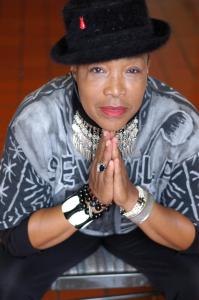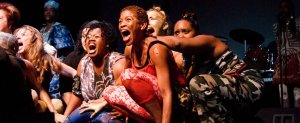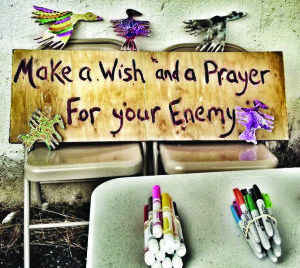IN A TIME of spiraling inequality, discontent and violence, the sometimes vapory subject of art’s relation to social justice takes on a cold, sober, even urgent aspect. As in the 1930s or the 1960s, it may even become of import to a broader public suddenly available to dialogue and action around a roiling status quo. At the least, a new festival devoted to showcasing a wide array of work by some outstanding Bay Area–based dance and performance makers working at the intersection of art and activism has a timely ring.

For three days and nights during the last weekend in February, “Blessed Unrest: An Arts and Social Justice Festival” will envelop CounterPulse’s new space on Turk Street with excerpted and full-length works by some 25 artists, variously steeped in struggles against racialized, gendered and class-based oppression. Notable veterans among them include choreographers Anne Bluethenthal, Joanna Haigood, and Amara Tabor-Smith, writer-performer Sara Moore, and the inimitable Rhodessa Jones, whose famed company, The Medea Project: Theater for Incarcerated Women, will cap each night with a different 25-minute performance.
The evening programs come bracketed by workshops and audience Q&As, while an interactive installation by renowned visual artist Yisrael K. Feldsott forms the basis of an opening night ritual event and is on site for the duration.
Through this multifaceted program, festival founder Polina Smith hopes to awaken a broader appreciation of socially engaged art and the roles it plays in mitigating injustice and cultivating social alternatives.
At the same time, “Blessed Unrest” is as much about introducing the various participating artists to one another as it is about introducing audiences to their work. Smith, a member of The Medea Project as well as the founder of her own devised theater company, Crescent Moon, says the idea for the festival arose out of her realization that many of the Bay Area’s most accomplished artist-activists were unaccountably siloed from one another.
“I started my MFA at CIIS [California Institute of Integral Studies] last January,” explains Smith during a conversation in December. “I started getting introduced to a lot of different artists working in different mediums who were all interested in arts and social change—and many of them didn’t know each other.” Smith, who studied theater in Montreal and came to San Francisco in 2008, was taken aback. “They’re doing amazing work! That’s really where the inspiration came from,” she says.
As for content, the artists she has invited cover a diverse set of subjects and practices. If, generally speaking, politically engaged art roams a broad territory in which differences in style and discipline can overshadow common ground—or, alternately, minimize political and ideological nuances—Smith has planned the talkbacks with the audience to involve all the artists presenting in a given evening to spur dialogue across varying approaches while illuminating some of this complexity.
In so large and diverse a lineup, the very definition of political art becomes an unstable category. Feldsott’s My Enemy Project, for example, which will be on view throughout the festival, is an inherently political intervention in its subject matter and design: it is made up of several large freestanding pieces, including six fi gures in orange, possibly awaiting execution, fl anked by soldiers standing guard and two self-immolating monks in postures of prayer. Behind the fi gures are panels bearing familial nouns in a variety of languages. The installation comes with an invitation to spectators to decorate small cut-out birds, which are then hung over the scene, with “a wish and a prayer for your enemy.”
Originally conceived as a “traveling medicine road show,” My Enemy Project initially accompanied the Feldsott on a drive from San Francisco to New York—where he was headed for a second edition of his lauded 2013 show, Cries, Chants, Shouts & Whispers: Songs of the Forgotten—and was set up at various sites of conflict across the country.
But Feldsott, whose striking primitivist paintings tend to ruminate with mystical, allegorical intensity on the brutality in the world and in human nature, eschewed the title of political artist in an interview with critic Robert C. Morris that same year.
“I don’t feel that I’m a political artist,” he told Morris on the occasion of the New York opening of Cries, Chants, Shouts & Whispers. “I sense that I’m painting from some mysterious level of my own humanity and the outrage that I feel in relationship to violence, disagreement or confl icts in the world is juxtaposed with the quality of cruelty, vengeance, and the need to destroy another people, another tradition, and another culture. These are really the issues that have galvanized me.”
This kind of response would seem to be perfectly in line with Blessed Unrest, however. If anything, the festival is designed to get past simplistic labels.
“I’m aware that [all the participating artists] are working at the intersection of art and social justice, whatever that means—it means different things to different people. That’s also an intention of mine in this festival,” she says, “to showcase the different ways we can be working in this field. So I’ve kept it really open. Their art will speak to that.”
Smith says her interest in the social power of performance was sparked by a high school drama teacher as well as a production she saw of Anna Deavere Smith’s Fires in the Mirror. The idea of using art as a way of bettering the world was a revelation then, though she understands that for many, at least in this country, it remains a dubious prospect.
“I was really interested in studying art for social change,” she notes, “and I had to go to Canada to do it because I couldn’t find any program in the States. In London, in the theater scene, there’s a whole movement called ‘theater and development’ or ‘theater and social change,’ and there are a lot of grants available for it. It’s recognized as its own field. And we just don’t have that here. People who are working in arts and social justice are competing with the same people who are applying for the opera and the ballet grants. They’re actually very different things. I think the artists know that, but I would really love for it to be more widely recognized by the public and, you know, grant committees. For people to really recognize the power that art has in affecting social change.”

Telling Their Stories
When I spoke with Rhodessa Jones in early December, she was between two workshop performances of a new solo piece, Fully Awake, Facing Seventy: “Heaven Betta Bea Honky-Tonk!” A show suffused with music, musings and reminiscences, Fully Awake continues the probing, stirring journey staged throughout her career as a towering performer, theater maker and activist—most recently in 2013’s Resurrection of SHE, which entwined her own remarkable life story with the work of The Medea Project, the company she founded some three decades ago as a platform for the stories of incarcerated women.
“My work is rooted in that exploration of self,” she explained, “learning to be self-expressed in a world gone mad; in a gender-hating world.”
Long a powerful advocate, ally and instigator for disenfranchised and marginalized women around the world, Jones conceived The Medea Project from this deep understanding of the need for self-exploration and expression.
“I was hired as an aerobics teacher, many years ago, to go into the jails,” explains Jones, recounting the origins of The Medea Project. “I’m always really fascinated at what those people in power—sometimes art-based power—want for their dollar. So I went, and the moment I entered this place my first question was, What does aerobics have to do with saving and changing the lives of these women? What really is called for? And what can I do, with everything that I have gathered in my own life up to this moment?
“We worked out, you know, we played volleyball, we played dodgeball. I used to dance professionally with a company, Tumbleweed, a very politically driven women’s group. We worked circus techniques, we worked tumbling, we worked contact improvisation. But all the while we were talking about the state of the world and woman’s place in it. So I brought this to the jail as well.”

Then came a crucial step.
“I started to talk about myself, who I was, while I stood on my hands and did back flips,” she laughs, “you know. They were fascinated that I was so strong and so capable, but also that I was sharing such intimate details about my life. I found intersections with them that had to do with looking for love in all the wrong places, betrayal, abandonment, of being mothers before we’re women, all these things. We kind of met in this space.”
Jones admits it was not easy to win over everyone, and recounts a somewhat harrowing showdown with one woman in particular. But that encounter proved instructive for both parties, she says. It not only helped Jones solidify her authority with the women; it guided her toward the nature of the work they would do together.
“I learned that people, first of all, need to be seen. Women need to be seen. And I learned that one of the best things I could do with this group of people was to get them to speak about what had happened to them. What was their journey? And that was amazing. It was just amazing.”
Extrapolating from her own journey, Jones devised The Medea Project as a literal stage on which formerly voiceless women could tell their stories. She also drew on classical mythologies, Greek and African, as frameworks for the struggles of The Medea Project’s subject-agents.
In addition to being theatrically intense, the work enacts a humanizing, socializing encounter between the women onstage and the audience. At the same time, by echoing the ancient wellsprings of Western and African cultures in the gritty honesty of the speakers’ lived experience, this encounter levels inimical distinctions, instead striking common ground between the revered but intangible heroines of our collective imagination and the women who are our forgotten, otherwise invisible contemporaries.
As an instance of art in the service of social justice, it is dramatically pure.
“How do we create space for people to feel like they are a part of the culture?” asks Jones, whose own work has done precisely that. “Especially with all the shame around getting busted, going to jail. There’s so much shame and fear. And also on our side—us “normal people,” I guess I can say—the concern, the consternation: What is their place in our lives?”
As for Blessed Unrest, Jones expects to present new work as well as highlights from a substantial repertoire.
“We have 25 years of work,” she notes. “I’m going to put other women’s words on some of the women I have now, because so many women have passed through The Medea Project. That’s pretty interesting— just treat them as actresses and see what they can relate to. Then we’re going to be doing a piece rooted in the whole Black Lives Matter movement. Then we’ll return to Birthright?, which is a piece we’ve been doing in association with Planned Parenthood. It’s going to be a mixture of the identity crisis that we’re going through in this culture, as well as women’s rights, women’s bodies. We’re going to revisit the reimagining of classics from the point of view of incarcerated women, but it will all be rooted in stories.”
“But it’s all concerned with social justice, how this is all part of the forward motion of us as a culture, to really compliment Polina’s idea as well as to leave the audience with something to chew on, on their way home.”
She adds, “Because I’m not interested in art for art’s sake. I’ve never been.”
This article appeared in the January 2016 issue of In Dance.


